GRAPHING TANGENT FUNCTIONS WITH TRANSFORMATIONS
Subscribe to our ▶️ YouTube channel 🔴 for the latest videos, updates, and tips.
Subscribe to our ▶️ YouTube channel 🔴 for the latest videos, updates, and tips.
We use the characteristics of the tangent curve to graph tangent functions of the form y = A tan (Bx- C), where B > 0
Step 1 :
Find two consecutive asymptotes by finding an interval containing one period.
A pair of consecutive asymptotes occurs at
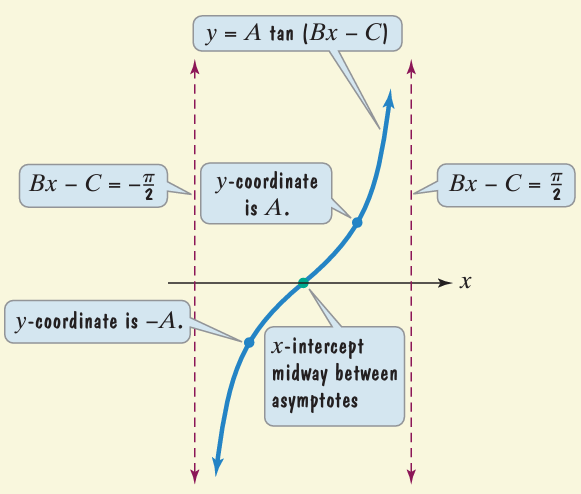
Step 2 :
Identify an x-intercept, midway between the consecutive asymptotes.
Step 3 :
Find the points on the graph 1/4 and 3/4 of the way between the consecutive asymptotes. These points have y-coordinate of -A and A respectively.
Step 4 :
Use the above steps to graph one full period of the function. Add additional cycles to the left or right as needed.
Problem 1 :
Graph y = 2 tan (x/2) for -π < x < 3π
Solution :
Step 1 :
Find two consecutive asymptotes, we do this by finding an interval containing one period.
An interval containing one period is (-𝜋, 𝜋). Thus two consecutive asymptotes occur at x = -𝜋 and x = 𝜋.
Step 2 :
Midpoint of x = -𝜋 and x = 𝜋.
An x-intercept is 0 and the graph passes through (0, 0).
Step 3 :
To find the points on the graph which is 1/4 and 3/4 of the way between two consecutive asymptotes, we follow
|
|
|
So, the required points on the curve are (-𝜋/2, -2) and (𝜋/2, 2).
Step 4 :
Vertical asymptote of y = tan x is k𝜋 + 𝜋/2, where k is integer. Here
x/2 = k𝜋 + 𝜋/2
x = 2(k𝜋 + 𝜋/2)
x = 2k𝜋 + 𝜋
x = 𝜋(2k + 1)
- When k = -1, x = -𝜋
- When k = 0, x = 𝜋
- When k = 1, x = 3𝜋
- When k = 2, x = 5𝜋
Repeat the same pattern in the interval.
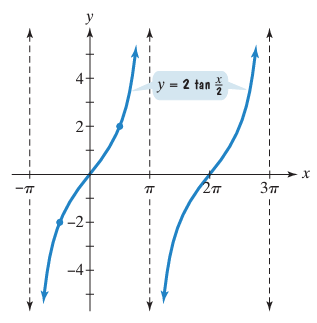
Problem 2 :
Graph two full periods of y = tan (x + π/4)
Solution :
Step 1 :
Find two consecutive asymptotes, we do this by finding an interval containing one period.
An interval containing one period is (-3𝜋/4, 𝜋/4). Thus two consecutive asymptotes occur at x = -3𝜋/4 and x = 𝜋/4.
Step 2 :
x-intercept :
So, x-intercept is at (-𝜋/4, 0)
Step 3 :
Points on the curve,
|
|
|
So, the required points are (-𝜋/2, -1) and (0, 1).
Step 4 :
Vertical asymptote of y = tan x is k𝜋 + 𝜋/2, where k is integer. Here
x + 𝜋/4 = k𝜋 + 𝜋/2
x = k𝜋 + 𝜋/2 - 𝜋/4
x = k𝜋 + (2𝜋-𝜋)/4
x = k𝜋 + 𝜋/4
x = 𝜋(k + 1/4)
- When k = -1, x = -3𝜋/4
- When k = 0, x = 𝜋/4
- When k = 1, x = 5𝜋/4
- When k = 2, x = 9𝜋/4
Repeat the same pattern in the interval.
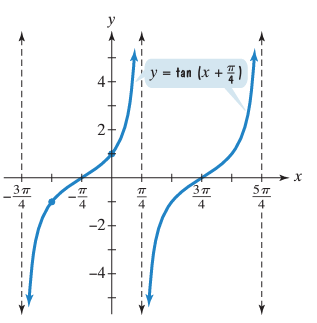
Problem 3 :
Graph two full periods of y = 3 tan (x/4)
Solution :
Step 1 :
Find two consecutive asymptotes, we do this by finding an interval containing one period.
An interval containing one period is (-2𝜋, 2𝜋). Thus two consecutive asymptotes occur at x = -2𝜋 and x = 2𝜋.
Step 2 :
x-intercept :
So, x-intercept is at (0, 0) at the interval (-2𝜋, 2𝜋). To get the more x-intercepts, we can find the midpoint of any two consecutive asymptotes.
Step 3 :
|
|
|
So, the required points are (-𝜋, -3) and (𝜋, 3).
Step 4 :
Vertical asymptote of y = tan x is k𝜋 + 𝜋/2, where k is integer. Here
x/4 = k𝜋 + 𝜋/2
x = 4(k𝜋 + 𝜋/2)
x = 4k𝜋 + 4(𝜋/2)
x = 4k𝜋 + 2𝜋
x = 2𝜋(2k + 1)
- When k = -1, x = -2𝜋
- When k = 0, x = 2𝜋
- When k = 1, x = 6𝜋
- When k = 2, x = 10𝜋
At these positions, we have consecutive asymptotes.
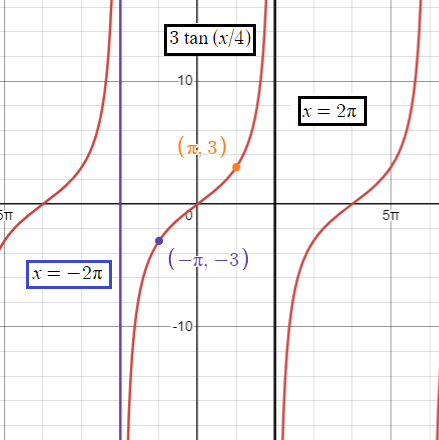
Problem 4 :
Graph two full periods of y = (1/2) tan (2x)
Solution :
Step 1 :
Find two consecutive asymptotes, we do this by finding an interval containing one period.
An interval containing one period is (-𝜋/4, 𝜋/4). Thus two consecutive asymptotes occur at x = -𝜋/4 and x = 𝜋/4.
Step 2 :
x-intercept :
Step 3 :
|
|
|
So, the required points are (-𝜋/8, -0.5) and (𝜋/8, 0.5).
Step 4 :
Vertical asymptote of y = tan x is k𝜋 + 𝜋/2, where k is integer. Here
2x = k𝜋 + 𝜋/2
x = (1/2)(k𝜋 + 𝜋/2)
x = (1/4)𝜋(2k + 1)
- When k = -1, x = -𝜋/4
- When k = 0, x = 𝜋/4
- When k = 1, x = 3𝜋/4
- When k = 2, x = 5𝜋/4
At these positions, we have consecutive asymptotes.
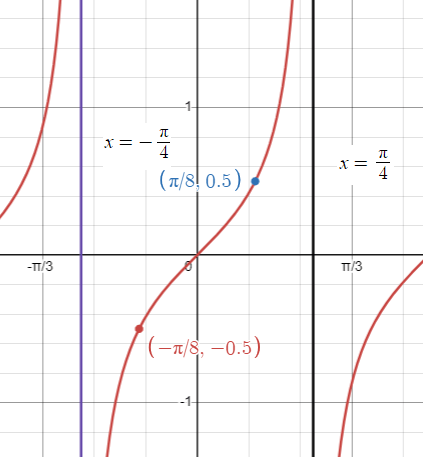
Problem 5 :
Graph two full periods of y = -2 tan (x/2)
Solution :
Since we have negative sign for 2, we have to reflect the graph across
Step 1 :
Find two consecutive asymptotes, we do this by finding an interval containing one period.
An interval containing one period is (-𝜋, 𝜋). Thus two consecutive asymptotes occur at x = -𝜋 and x = 𝜋.
Step 2 :
x-intercept :
Step 3 :
|
|
|
So, the required points are (-𝜋/2, -2) and (𝜋/2, 2).
Step 4 :
Vertical asymptote of y = tan x is k𝜋 + 𝜋/2, where k is integer. Here
x/2 = k𝜋 + 𝜋/2
x = 2(k𝜋 + 𝜋/2)
x = 2k𝜋 + 𝜋
x = 𝜋(2k + 1)
- When k = -1, x = -𝜋
- When k = 0, x = 𝜋
- When k = 1, x = 3𝜋
- When k = 2, x = 5𝜋
At these positions, we have consecutive asymptotes.
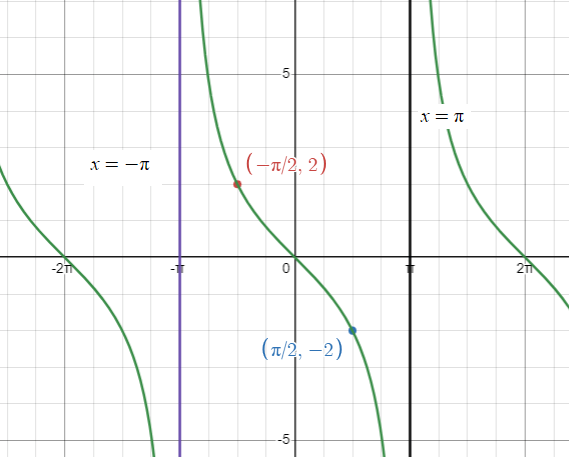
Recent Articles
-
Finding Range of Values Inequality Problems
May 21, 24 08:51 PM
Finding Range of Values Inequality Problems -
Solving Two Step Inequality Word Problems
May 21, 24 08:51 AM
Solving Two Step Inequality Word Problems -
Exponential Function Context and Data Modeling
May 20, 24 10:45 PM
Exponential Function Context and Data Modeling